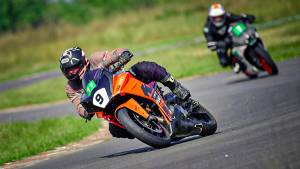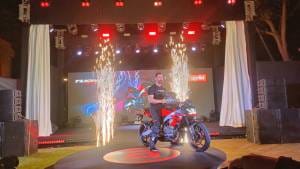Track test: Yamaha YZF-R3 vs KTM RC 390 vs Kawasaki Ninja 300
The racetrack. It's a place where actions speak and words do not. Where you either bring it or admit that you don't have what it takes. A battle between new class of 300s is something we've looked forward to for a long time. To have an undiluted test where the ability of the pillion seat or the power of the headlight doesn't distract from the purity of the sportsbike. Where all that matters is how hard it goes, how hard it stops and how fast can it corner. Here are India's top small sportsbikes at India's toughest, most technical racetrack.

Kawasaki Ninja 300
Track test: Ninja 300 vs KTM RC 390 vs Yamaha YZF-R3
| Kawasaki Ninja 300 | |
| Type | 8v DOHC liquid-cooled fuel-injected 296cc parallel twin |
| Max power | 39PS@11,000rpm |
| Max torque | 27Nm@10,000rpm |
| Rake/trail | 27°/94mm |
| Wheelbase | 1403mm |
| Kerb weight | 174kg |
| 0-100kmph | 7.2s |
| Top speed | 162kmph |
| Price (on-road Mumbai) | Rs 4.12 lakh |
| KTM RC 390 | |
| Type | 4v DOHC liquid-cooledfuel-injected 373cc single |
| Max power | 43.5PS@9,000rpm |
| Max torque | 35Nm@7,000rpm |
| Rake/trail | 25°/99mm |
| Wheelbase | 1340mm |
| Kerb weight | 166kg |
| 0-100kmph | 5.7s |
| Top speed | 167kmph |
| Price (on-road Mumbai) | Rs 2.42 lakh |
| Yamaha YZF-R3 | |
| Type | 8v DOHC liquid cooled fuel injected 321cc parallel twin |
| Max power | 42PS@10,750rpm |
| Max torque | 29.6Nm@9,000rpm |
| Rake/trail | 25°/94mm |
| Wheelbase | 1,380mm |
| Kerb weight | 169kg |
| 0-100kmph | 6.4s |
| Top speed | 173.9kmph |
| Price (on-road Mumbai) | Rs 3.98 lakh |
Best lap time: 1m 21.7s
The Japanese have always found it hard to focus their motorcycles sharply. They're capable of it, of course. The flagship motocrosser, or sportsbike will not lack focus and will enthusiastically trade in, say, comfort if it gets in the way of performance. But smaller, mid-order motorcycles aren't permitted this luxury. The Ninja 300 exemplifies this. Its trump card has traditionally been a setup that balances the needs of everyday in-traffic comfort with a sporty cant and the demands of fast canyon roads or indeed, the track. At the road test two years ago, the Ninja 300 showed off this flexibility to great effect.
 The Kawasaki Ninja 300 is the oldest motorcycle of the three. However, the meters are clear and well-specced and in that one area the segment hasn't made a big leap forward. A sweet motorcycle to ride, the lack of ABS on the bike is something that Kawasaki needs to fix
The Kawasaki Ninja 300 is the oldest motorcycle of the three. However, the meters are clear and well-specced and in that one area the segment hasn't made a big leap forward. A sweet motorcycle to ride, the lack of ABS on the bike is something that Kawasaki needs to fix
A look under the skin reveals quickly that this versatile tilt is neither new nor accidental. The engine grew to its 296cc displacement while being calmed down via a lower compression ratio. The extra cubes released a calmer natured power and torque - peak torque was 27PS and peak power went up to 39PS at 11,000rpm. Peak torque was at 10,000rpm, but unlike the previous engine, torque is available at lower revs too. On the street, 4,500rpm can be fun and at the track, 7,000rpm can be lived with. Small bikes always put a premium on being in the right gear, there isn't any getting away from that. But the Ninja's more flexible now and that allows a wider-spaced set of ratios. In the same sort of mood, the chassis uses the most relaxed geometry of this trio and the longest wheelbase.
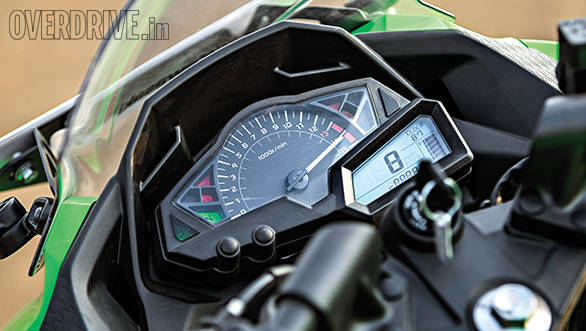
How does that translate to the track? The Ninja is quick on its feet but not the quickest here. Between its heavy weight, and the fact that the competition has had the time to benchmark it thoroughly, the Ninja loses the straight line battle. It's the slowest to 100kmph, posts the lowest top trap speed and has the slowest lap time as well.
But let that not distract you from what the Ninja does well. The Ninja is a composed motorcycle that is pretty quick and capable on its own. The data shows that it loses time in the chicanes when one must flip from full lean left to full lean right. It also loses ground in the complicated turn one sequence where stability and confidence have to be sky high for a fast transit.
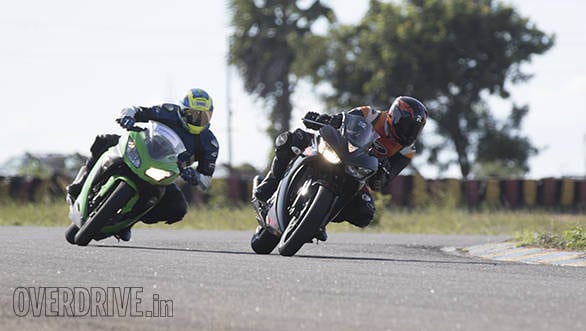
But you'd have to be a seasoned racer to notice this. Because the Ninja makes you feel comfortable. Rider confidence is a big part of riding well, and when the intended target is new riders, that's of vital importance. The suspension setup is distinctly stiffer than the Yamaha. This feels right and you start pushing the Kawasaki hard within a few corners.
As you will discover, this feels good. Turn in is fast and assured and the Ninja 300 feels spot on. The transition to a natural feeling at high lean angles mid-corners is smooth and the Kawasaki comes back on the power smoothly. Pick the right gear and you'll exit smoothly too.
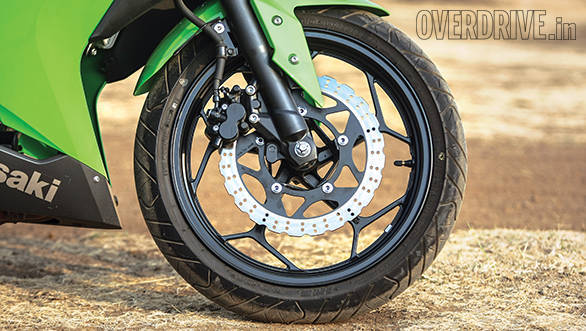
Turn the wick up and you'll realise why despite the feelings, the Kawasaki is losing time. Factor one is the tyres. The IRCs are good tyres but in this company, the MRFs have their number and the Metzelers are just vastly superior. Second, the Ninja 300 is now the heaviest of the trio at 174kg and its engine gives it the least oomph of all three as well. GPS-measured actual speed at the trap was 144.4kmph, almost 5kmph slower than the others.
The Ninja 300 is still an excellent all-round small sportsbike that will be lovely on commute and terrific out on the highway. But at the racetrack, it's outgunned.
KTM RC 390
Track test: Ninja 300 vs KTM RC 390 vs Yamaha YZF-R3
| Kawasaki Ninja 300 | |
| Type | 8v DOHC liquid-cooled fuel-injected 296cc parallel twin |
| Max power | 39PS@11,000rpm |
| Max torque | 27Nm@10,000rpm |
| Rake/trail | 27°/94mm |
| Wheelbase | 1403mm |
| Kerb weight | 174kg |
| 0-100kmph | 7.2s |
| Top speed | 162kmph |
| Price (on-road Mumbai) | Rs 4.12 lakh |
| KTM RC 390 | |
| Type | 4v DOHC liquid-cooledfuel-injected 373cc single |
| Max power | 43.5PS@9,000rpm |
| Max torque | 35Nm@7,000rpm |
| Rake/trail | 25°/99mm |
| Wheelbase | 1340mm |
| Kerb weight | 166kg |
| 0-100kmph | 5.7s |
| Top speed | 167kmph |
| Price (on-road Mumbai) | Rs 2.42 lakh |
| Yamaha YZF-R3 | |
| Type | 8v DOHC liquid cooled fuel injected 321cc parallel twin |
| Max power | 42PS@10,750rpm |
| Max torque | 29.6Nm@9,000rpm |
| Rake/trail | 25°/94mm |
| Wheelbase | 1,380mm |
| Kerb weight | 169kg |
| 0-100kmph | 6.4s |
| Top speed | 173.9kmph |
| Price (on-road Mumbai) | Rs 3.98 lakh |
Best lap time: 1m17.52s
In the company of these refined twins, the RC 390 feels like a tractor as you trundle out of pit lane. But as soon as you open the gas with intent, the torque of the single cylinder and its significantly lower weight assert themselves with great authority. The KTM engine is not about refinement, it's about brute force. It likes to be handled with a firm hand and if you aren't careful, it slams into the rev limiter without warning or remorse. This makes keeping the KTM on the boil a tiny bit harder than it needs to be, but the KTM engine is rewarding to thrash.
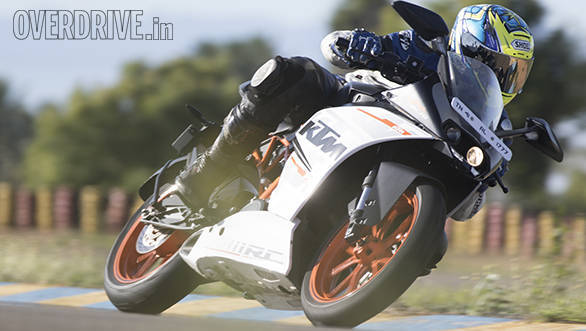
Keep it well above 7,000rpm and shift up around 9,500rpm and the engine pulls and pulls and pulls. The KTM handily racked up 151.7kmph before braking for turn one, the highest speed we recorded on this test. The light action gearbox never misses a shift and the powertrain of the KTM really is excellent for this job. It's a good thing the frame keeps up as well. The Metzelers and the trellis frame work well with the stiff suspension setup. Unlike the other two bikes, it does take a few laps to settle into the KTM's feel. But once you've understood it, riding hard is easy. The front-end inspires a lot of confidence and the grip from the tyres is almost impossible to exceed. This makes riding ever harder as natural as a kid eating ice cream.
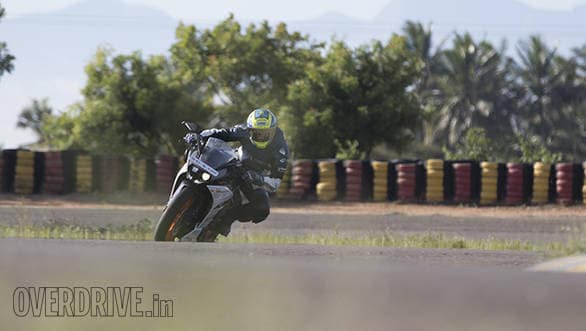
Turn-in on the KTM is absolutely neutral. It feels completely natural and it encourages you to turn harder and trust the front-end more. Lovely, really. Mid-corner, the short wheelbase plays second fiddle to the grippy tyres making for a stable, confident feel at high lean angles. The broad power of the single arrives hard on the exit and it's the least sensitive to which gear you are in at this track. The hard setup does put a premium on doing things right. For example, there are bumps in the middle of the second chicane that only feel harmless if you can open the gas before your wheels go over them. On the KTM, it's vital to have things done right, else you lose time and a bit of confidence. Anand also pointed out that the KTM is happy to lean ever harder, something both the other bikes don't do with such eagerness. The reason, of course, is the aggressive profile of the Metzelers which we know also endow the Duke with the same tendency.
 The KTM is the lightest and most powerful of the trio. It is also the least refined. Note the black scrape marks on the bottom of the fairing hard cornering on the RC is intense, but that fairing grinds down. All digital meters take some getting used to. Standard ABS it's the only bike here to offer this crucial safety feature
The KTM is the lightest and most powerful of the trio. It is also the least refined. Note the black scrape marks on the bottom of the fairing hard cornering on the RC is intense, but that fairing grinds down. All digital meters take some getting used to. Standard ABS it's the only bike here to offer this crucial safety feature
Unfortunately, this is not always a good thing. KTM chose a box-section for the bottom of the street fairing and that's a problem. Go fast enough and the edges start to grind down harder and harder. Indeed, Rohit, riding his own RC, managed to ground his fairing so hard that it levered him off the motorcycle and into the gravel. Clearly, KTM understands this because the racing RC 390 kit includes a V-bottomed race fairing that will be nearly impossible to deck.
The other weakness, also well known, is that the KTM has the weakest brakes of this bunch. On my first lap after hopping off the R3, I nearly had a heart attack when the KTM's brakes seemed like they would not slow the bike down enough for turn one. Not something you want to see slowing from 150kmph. Of course, they worked after a fashion, thank god. It is also the only bike here with ABS.
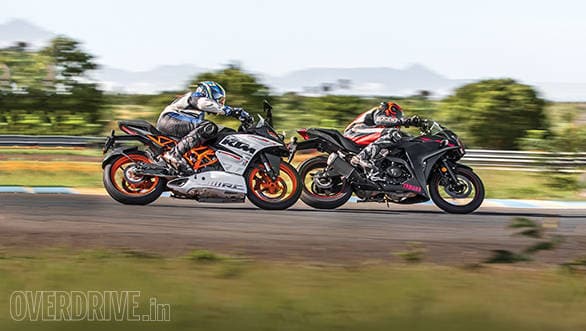
But KTM really should look at the brakes. Rishaad runs a set of EBC HH pads on his KTM 390 Duke that solves the braking issue. This will probably cause rotor wear in the long run, but hey, KTM parts are cheap.
The thing about the RC 390 is that in this group of newbie-friendly sportsbike, it is the one that wants the most commitment and skill from the rider. It doesn't like being handled badly and it feels the most like the bike that will bite a careless hand. The flip side of that is that you can keep getting faster and faster on the KTM without running out of motorcycle to keep up with you. It's the motorcycle a fast, skilled rider will settle into over four or five laps and then reel off faster and faster laps the rest of the day.
Yamaha YZF-R3
Track test: Ninja 300 vs KTM RC 390 vs Yamaha YZF-R3
| Kawasaki Ninja 300 | |
| Type | 8v DOHC liquid-cooled fuel-injected 296cc parallel twin |
| Max power | 39PS@11,000rpm |
| Max torque | 27Nm@10,000rpm |
| Rake/trail | 27°/94mm |
| Wheelbase | 1403mm |
| Kerb weight | 174kg |
| 0-100kmph | 7.2s |
| Top speed | 162kmph |
| Price (on-road Mumbai) | Rs 4.12 lakh |
| KTM RC 390 | |
| Type | 4v DOHC liquid-cooledfuel-injected 373cc single |
| Max power | 43.5PS@9,000rpm |
| Max torque | 35Nm@7,000rpm |
| Rake/trail | 25°/99mm |
| Wheelbase | 1340mm |
| Kerb weight | 166kg |
| 0-100kmph | 5.7s |
| Top speed | 167kmph |
| Price (on-road Mumbai) | Rs 2.42 lakh |
| Yamaha YZF-R3 | |
| Type | 8v DOHC liquid cooled fuel injected 321cc parallel twin |
| Max power | 42PS@10,750rpm |
| Max torque | 29.6Nm@9,000rpm |
| Rake/trail | 25°/94mm |
| Wheelbase | 1,380mm |
| Kerb weight | 169kg |
| 0-100kmph | 6.4s |
| Top speed | 173.9kmph |
| Price (on-road Mumbai) | Rs 3.98 lakh |
Best lap time: 1m18.23s
You cannot help but fall in love with the Yamaha the moment you climb on. I don't know how Yamaha has managed it but you feel like you know the R3 intimately from the first moment. Luckily, it's exactly how the motorcycle behaves as well.
A strong highlight of the experience is the engine. The 321cc twin is new and as small twins are wont to do, power arrives higher up in the revs. But the Yamaha engine is such a smooth beauty. It sounds absolutely in its element at redline or anywhere else. And once you get it shrieking along, it also makes a very nice turn of power. A sweet gearbox adds to the good feelings and while I wasn't expecting it to feel so different to the Kawasaki, the Yamaha really does tick a few extra boxes in the "this feels great" department.

The tubular diamond type chassis, if you've ever ridden an R15 hard, is a familiar unit. Yamaha, once again, goes for a soft setup with sporty ergonomics that are vastly easier to live with than the KTM. The clip-on bars, for instance, are a very clever configuration because they'll work on the highway as well as at the racetrack. The suspension's softness will offer good ride quality but you can get the Yamaha up to a fairly impressive clip without the softness of the suspension becoming an issue. In fact, only after you put a full-on racer in the saddle and he decides to set a lap record will complaints about soft suspension surface.

The other side of that coin is that the R3 is a forgiving motorcycle. You can make a mistake at any part of a corner and then find a non-alarming way to bring it back in line smoothly. That, more than anything else, reminds me strongly of why the R15, especially the first one, was such a great track riding learning tool. The brakes, similarly, are very strong but the bite is well-judged. However, only the KTM offers ABS in India in this class and that's a shame.
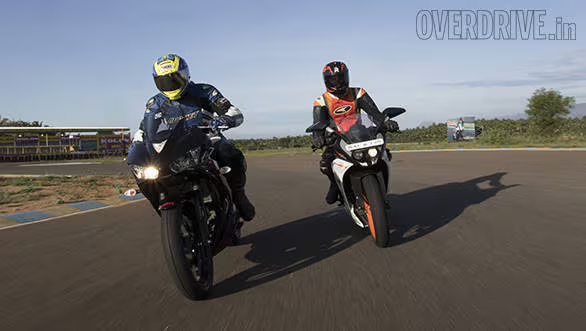
The Yamaha's weakness is its tyres. Yamaha uses a set of extremely capable MRF tyres on the R3. They're sticky and they're trustworthy through most of the riding. However, approaching fast lap times, you can feel a judder at the rear of the motorcycle that becomes more and more pronounced. And that's the MRF telling you loud and clear that it doesn't have any more left to offer. While I do appreciate the warning, I suspect that the Yamaha on better tyres would probably match the KTM's lap times. And you'd come away having expended a lot less effort and feeling like you rode a lot further from the edge of adhesion.
I wasn't expecting the R3 to be such a revelation, especially given the rampant RC 390. But the Yamaha really is a sweet little thing with great talent and ability.
Verdict
It is pretty clear that the Ninja 300's age is showing. It might represent the genesis of the segment as well as its steady displacement creep, but it now needs a tune-up to compete. Its abilities are good enough for the all-round real world experience, but at the track, the Kawasaki's going to be fast, but behind. That brings us to a battle which we weren't expecting to be so close and yet so far apart. The Yamaha and the KTM post roughly the same sort of performance. Which is credit to the Yamaha since it has to overcome both a slight power and torque deficit and a weight disadvantage. That it can do this with the MRFs which are great but not in the Metzeler league is a testament to how capable the R3 is.
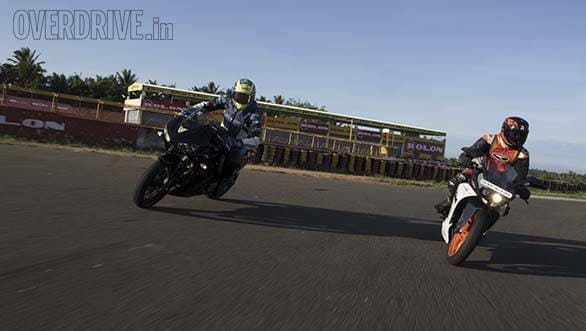
On the other hand, the nature of the two motorcycles couldn't be further apart within the boundaries of being newbie-friendly sportsbikes. The KTM is at the sharp, hardcore end of the spectrum. It wants to be told exactly what to do. It wants commitment and skill and it'll execute with precision. It's forgiving too but not like the Yamaha, and it doesn't enjoy forgiveness as a riding plan.
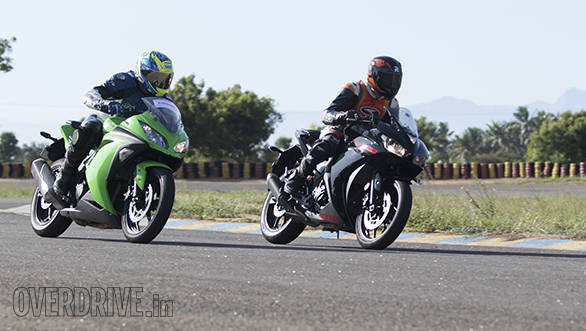
The Yamaha is a big softie at heart. It feels friendly, trustworthy and happy from the off. Both the engine and the chassis produce a brand of refined, alert performance that puts you at ease and encourages you to push harder and extract more. It's this friendliness that leads you rapidly to the limits of its tyres and thankfully, the MRFs signal the limit with good articulation too. Given the fact that the Yamaha costs Rs 1.5 lakh more than the KTM, I thought the track test would be won by the Austro-Indians easily. Turns out it isn't that simple. The KTM is very much the hardcore sportsbike, a stunningly good deal and extraordinarily inexpensive to live with. And hence the winner here.
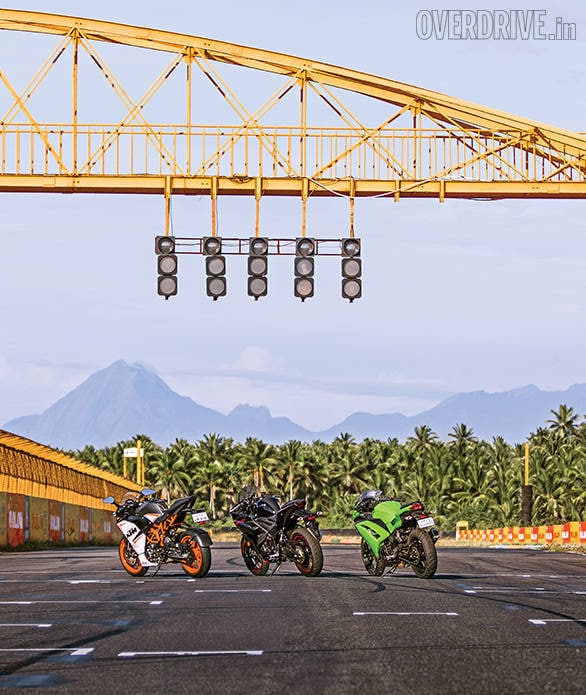
But the Yamaha is just stunning. It nearly matches the KTM's actual performance while requiring much less effort from the rider. It's so friendly and so familiar that riding it is great fun. And with better tyres, the R3 will be an absolute hoot too. Is the KTM the better deal? Yes, it is. Does that mean you shouldn't bother with the Yamaha? Hell, no. If you've had your heart set on a twin-cylinder motorcycle and the higher price doesn't deter you, then the Yamaha is, without question, the motorcycle to buy. It's a solid track bike and I suspect road test next month it'll be a terrific road bike too.
Images by Ishaan Bhataiya
Track test: Ninja 300 vs KTM RC 390 vs Yamaha YZF-R3
| Kawasaki Ninja 300 | |
| Type | 8v DOHC liquid-cooled fuel-injected 296cc parallel twin |
| Max power | 39PS@11,000rpm |
| Max torque | 27Nm@10,000rpm |
| Rake/trail | 27°/94mm |
| Wheelbase | 1403mm |
| Kerb weight | 174kg |
| 0-100kmph | 7.2s |
| Top speed | 162kmph |
| Price (on-road Mumbai) | Rs 4.12 lakh |
| KTM RC 390 | |
| Type | 4v DOHC liquid-cooledfuel-injected 373cc single |
| Max power | 43.5PS@9,000rpm |
| Max torque | 35Nm@7,000rpm |
| Rake/trail | 25°/99mm |
| Wheelbase | 1340mm |
| Kerb weight | 166kg |
| 0-100kmph | 5.7s |
| Top speed | 167kmph |
| Price (on-road Mumbai) | Rs 2.42 lakh |
| Yamaha YZF-R3 | |
| Type | 8v DOHC liquid cooled fuel injected 321cc parallel twin |
| Max power | 42PS@10,750rpm |
| Max torque | 29.6Nm@9,000rpm |
| Rake/trail | 25°/94mm |
| Wheelbase | 1,380mm |
| Kerb weight | 169kg |
| 0-100kmph | 6.4s |
| Top speed | 173.9kmph |
| Price (on-road Mumbai) | Rs 3.98 lakh |
Starts Rs 3,18,000
296cc
6-Speed
39.00
27.00
28.06 Kmpl
Starts Rs 3,14,000
373cc
6-Speed
43.50
35.00
-NA-
Starts Rs 3,50,180
321cc
6-Speed
42.00
29.60
-NA-

